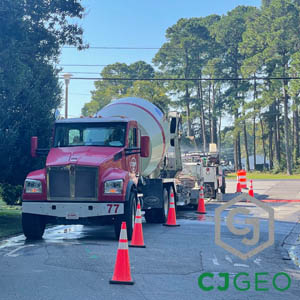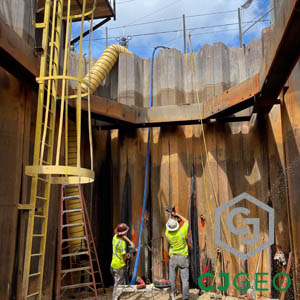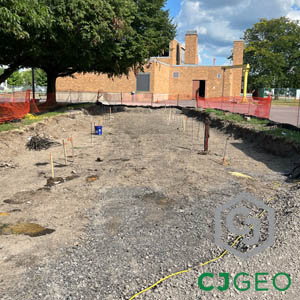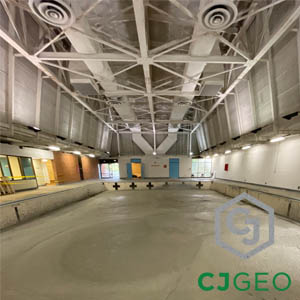Pipelines & Tunneling
-

Communication Jack & Bore Grouting
The Job The Sandston area, just outside of Richmond, Virginia, is at the crossroads of major nort...
-

Tunnel Abandonment – Boston
THE JOB A plumbing contractor hand tunneled 140LF of 4’x5′ tunnel under two apartment buildings n...
-

Sewer Collapse Sinkhole Repair
The Job This sewer collapse sinkhole repair project is located in central Virginia. When the oper...
-

Multiplate Tunnel Grouting
The Job This multiplate tunnel grouting project is located in Asheville, North Carolina. During a...
-

HRSD 24″ Forcemain Abandonment
The Job HRSD‘s Virginia Beach Boulevard Forcemain Replacement project installed more than a...
-

MTBM Recovery Grouting
The Job This MTBM recovery grouting project is located in Florida. When a 42″ MTBM stopped ...
-

Launch Shaft Permeation Grouting
The Job This launch shaft permeation grouting project is located in Fort Myers, Florida. As part ...
-

Georgia Annular Space Grouting
The Job This Georgia annular space grouting project is located in Athens, Georgia. The project in...
-

Tennessee Annular Space Grouting
The Job This Tennessee annular space grouting project is located in Brentwood. Brentwood is part ...
-

Power Station Pipe Abandonment
The Job This power station pipe abandonment project is between Richmond & Lynchburg, Virginia...
-

Rising Mains 48″ Abandonments
The Job This Pittsburgh pipe abandonment project is located within the city of Pittsburgh, Pennsy...
-

SW Florida Annular Space Grouting
The Job This Florida annular space grouting project by CJGeo is located in For Myers, Florida. Th...
-

New York Annular Space Grouting
The Job This New York annular space grouting work is part of the Bay Park Conveyance Project. The...
-

Dairy Branch Annular Space Grouting
The Job CJGeo’s Dairy Branch annular space grouting project is located in North Carolina. C...
-

Neuse River Annular Grouting
The Job This annular grouting project is located in North Carolina. The City of Raleigh’s N...
-

24″ Water Main Abandonment
The Job This 24″ water main abandonment project is located in Fairfax, Virginia. Fairfax Co...
-

Union County Annular Space Grouting
The Job This Union County annular space grouting project is located in North Carolina, near Charl...
-

8″ Pipe Abandonment
The Job This 8″ pipe abandonment project is located outside of Washington, DC. As part of c...
-

CBBT Sheet Pile Pregrouting
The Job This sheet pile pregrouting project is located in the Chesapeake Bay. The Chesapeake Bay ...
-

Garden State Parkway grouting
The Job This Garden State Parkway grouting project is located near Middletown, New Jersey. As par...
-

66″ Water Main Abandonment
The Job This 66″ water main abandonment is part of the The Purple Line’s construction...
-

Atlanta cellular concrete
The Job This Atlanta cellular concrete installation is part of Atlanta Watershed Management’...
-

8′ CMP Joint Grouting
The Job A spec warehouse was planned for a vacant piece of land which had 1700LF of 8′ CMP ...
-

Valve Vault Infiltration Grouting
The Job This valve vault infiltration grouting project is part of the Purple Line project in Mary...
-

Lightweight Pipe Backfill
The Job This lightweight pipe backfill is part of the City of Alexandria’s RiverRenew proje...
-

Dumfries Pipe Abandonment
The Job This utility relocation included abandonment grouting as part of a VDOT roadway reconstru...
-

Parsippany Annular Space Grouting
The Job This Parsippany annular space grouting project is part of a microtunneled installation of...
-

BNA Culvert Abandonment
The Job As part of a Nashville International Airport’s BNA Vision project, several hundred ...
-

Nashville Annular Space Grouting
The Job This Nashville annular space grouting project is located at Nashville’s Central WWT...
-

Sheet Pile Joint Sealing
The Job This sheet pile joint sealing work is part of the Thimble Shoals parallel tunnel project....
-

Microtunnel Contact Grouting
The Job This microtunnel contact grouting project is located in Clarksville, Tennessee. It is par...
-

Texas Annular Space Grouting
The Job This Texas annular space grouting project is located in Lockhart, Texas. It is a 42″...
-

Michigan Water Main Abandonment
The Job This Michigan water main abandonment project is located in Saginaw, Michigan. It is a 290...
-

Pennsylvania Pipe Abandonment
The Job This Pennsylvania pipe abandonment project is located at a drinking water reservoir near ...
-

New Jersey Pipe Abandonment
The Job This New Jersey pipe abandonment project is located in northern New Jersey. First, the ge...
-

Pregrouting for Hand Mining
The Job This large CSO project in Alexandria, Virginia required pregrouting for hand mining. The ...
-

Michigan Pipe Abandonment
The Job This Michigan pipe abandonment project is located in Grand Rapids, Michigan. As part of t...
-

Detroit Michigan Annular Space Grouting
The Job This Detroit Michigan annular space grouting project is located near Van Dyke Avenue &...
-

SOE Closure Manchette Grouting
The Job This SOE closure Manchette grouting project is located in Alexandria, Virginia. It is par...
-

Virginia Pipe Abandonment
The Job This Virginia pipe abandonment project is located in Norfolk, Virginia. It is part of the...
-

North Carolina Abandonment Grouting
The Job This North Carolina pipe abandonment project is located in Raleigh, North Carolina. It is...
-

48 Inch RCP Joint Repair
The Job This 48 inch RCP joint repair project is located in Raleigh, North Carolina. The pipe is ...
-

HDPE Annular Grouting
The Job This HDPE annular grouting project is located in Portsmouth, Virginia. The project owner ...
-

SOE Leak Grouting
The Job This SOE leak grouting project is located in Alexandria, Virginia. It is part of the Rive...
-

Outfall Leak Grouting
The Job This outfall leak grouting project is located near Emporia, Virginia. The work is located...
-

New Jersey permeation grouting
The Job This New Jersey permeation grouting project is located in Elizabeth, New Jersey. It is at...
-

Railroad Bore Annular Space Grouting
The Job This railroad bore annular space grouting project is located in Winchester, Virginia. As ...
-

Electric Bore Annular Space Grouting
The Job This electric bore annular space grouting project is located in Norfolk, Virginia. As par...
-

North Carolina Annular Grouting
The Job This North Carolina annular grouting project is located in Havelock, North Carolina. Have...
-

Flooded Shaft Grouting
The Job This flooded shaft grouting project by CJGeo is located outside of Washington, DC at a da...
-

Penstock Void Grouting
The Job This penstock void grouting project is located near Hopkinton, New Hampshire. It is locat...
-

WWTP Tunnel Curtain Grouting
The Job This WWTP tunnel curtain grouting project is located in Syracuse, New York. It is located...
-

Indoor Pool Abandonment
The Job This indoor pool abandonment project is located in West Virginia, at Concord University. ...
-

New York Pipe Abandonment
The Job This New York pipe abandonment project is located in Newburgh, New York. Newburgh is on t...
-

Indiana Pipe Abandonment
The Job This Indiana pipe abandonment project is located in Anderson. Anderson is in central Indi...
-

Ohio Annular Space Grouting
The Job This Ohio annular space grouting project is located in Akron. It is part of the Northside...
-

NCDOT pipe abandonment
The Job This NCDOT pipe abandonment project is located outside of Wilmington, North Carolina. It ...
-

NCDOT abandonment grouting
The Job This NCDOT abandonment grouting project is located outside of Chapel Hill, North Carolina...
-

Tunnel Shaft Sinkhole Grouting
The Job This tunnel shaft sinkhole grouting project is located in Newport News, Virginia. It is l...
-

USACE Pipe Abandonment
The Job This USACE pipe abandonment project is located in Muncie, Indiana. The project was part o...
-

Hobas Pipe Backfilling
The Job This Hobas pipe backfilling project is located in Baltimore, Maryland. It is one of the l...
-

TBM Intervention Permeation Grouting
The Job This TBM intervention permeation grouting project is located in Virginia. It is part of a...
-

Collapsed CMP Abandonment
The Job This collapsed CMP abandonment project is located at a paper mill near Richmond, Virginia...
-

Fort Lauderdale Permeation Grouting
The Job This Fort Lauderdale permeation grouting project is located next to Port Everglades. Port...
-

Slurry Wall Gap Closure Grouting
The Job This slurry wall gap closure grouting work is part of CJGeo’s continuing permeation...
-

Lightweight Fill Over Waterline
The Job This lightweight fill over waterline project is located north of Baltimore, Maryland, in ...